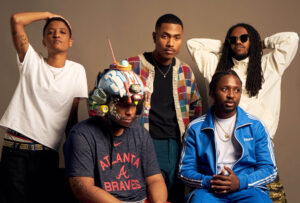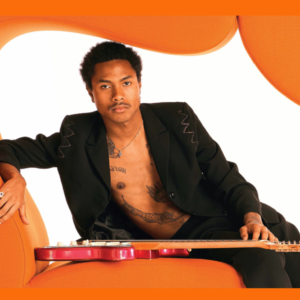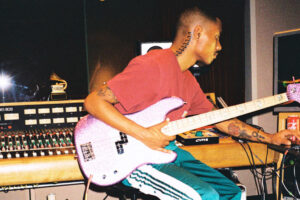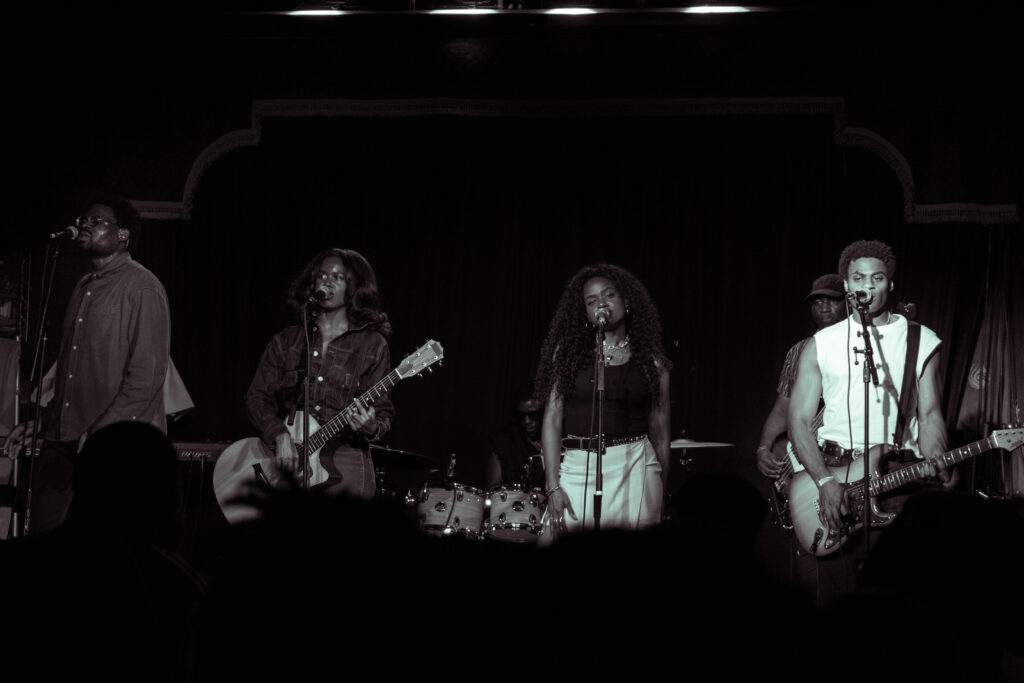Track-by-Track: Steve Lacy’s Apollo XXI (2019)
Written by Julianna Smith on October 20, 2021
To be completely honest, this article has been a long time coming.
Apollo XXI has been one of my favorite albums for quite awhile now–although it did take me several months to fully appreciate it. It’s an uncommon blend of funk, neo-soul, R&B, jazz, and indie rock elements, and it often takes first-time listeners a minute to adjust to the radical sound (which I’ve learned when playing it for people).
Steve Lacy‘s renowned as a somewhat “eccentric” producer; you may have heard of him as the producer who used GarageBand on his iPhone to create “PRIDE.,” the 7th track off Kendrick Lamar‘s album DAMN. He got his start in music in elementary school, where he impressed classmates by playing beats with two pens.
Eventually, Lacy expanded his horizons and went on to learn bass, guitar, and production. Matt Martians met Lacy when the two were still in high school, enlisting him in musical collective the Internet. In 2015, that band scored a Grammy nomination for their album, Ego Death (which Lacy produced). This success inspired Steve Lacy to fully commit to a career in music.

The Internet, courtesy of the New York Times
In April of 2019, Steve Lacy dropped the album’s lead single, titled “N Side.” A week before the final album’s release, the other two singles, “Playground” and “Hate CD,” were released (on May 21 and May 24, respectively). Mere hours after “Hate CD” dropped, Apollo XXI was released in full.
The album is distinctively funky, delivering on the 70’s-inspired promise made by the stylish orange album cover. Critics picked up on the thematic elements of the album, lyrically and instrumentally, but had mixed feelings. Reviews ranged from slight disappointment to high praise.

Apollo XXI’s cover art
I can understand both the praise and criticism of the album — it is somewhat timid and one-note at times, but I think there’s an argument to be made that that was simply how Lacy envisioned it. Creating a unique sort of pixelated, hippie dreamworld of sound seemed to be his overarching purpose for the album, and I think it’s hard to argue that he didn’t accomplish that. Thus, although I think the more technical critiques of Apollo XXI are completely reasonable, its still quite a feat of an album, especially as a debut solo project.
That’s enough general commentary from me, though. Let’s get into the track-by-track!
Track 1: “Only If” (1:40)
The album opens with “Only If,” a funky, bouncy, trippy ride of a track. The first seconds open with a distinctive whooshing sound paired with a steadily bumping bass. rhythm. Moments later, Lacy layers in some psychedelic electric guitar, which fades shortly after, making room for the vocal line. This track defines the tone of the album well, encapsulating the primary musical and lyrical themes, despite its brief duration.
Track 2: “Like Me” (9:04)

Courtesy of Genius
The nine minute second track of the album is a massive undertaking for Lacy, whose focus on beat-making is best suited for shorter, looping tracks. “Like Me” is a journey of a song, including a feature by DAISY WORLD and multiple melodic lines. The lyrics explore the many struggles non-cisgender-heterosexual people face when coming to terms with their identity. This isn’t my favorite track by Lacy, but it is without a doubt one of the most impactful songs on the record.
Track 3: “Playground” (3:33)
One of my personal favorites on the album, “Playground” is a jaunty, psychedelic rock song that sounds like how carnival rides feel (I would say rollercoaster, but if they scare you then maybe, like, the spinning teacup ride). It’s a fun ride of a song, with flirty lyrics reminiscent of early 2000’s club songs–think “Shut Up and Drive” by Rihanna. The playful instrumentals of the song pair well with the direct, innuendo-rich lyrics, making this a memorable track.
Track 4: “Basement Jack” (1:49)
“Basement Jack” is one of the most clever tracks on the album. Instrumentally, a steady beat bumps in the background, keeping the tempo of the song up, while a catchy electric line loops; on top of it all, Lacy’s slightly-reverbed voice alternates between crooning and speak-singing. Brilliantly charming lyrics repeat in the choruses:
“Love me like your doja, ride me like your lover / Touch me round my wasteland, I’ve been out the basement.”
This track’s content is similar to that of “Playground,” the previous track, but I think it’s more successfully executed here. What makes “Basement Jack” stand out is the briefness of the song; pairing this beat with Lacy’s characteristically flirtatious lyrics makes for a wildly catchy track which will be stuck in your head all day (not that I would complain–it is a great song).

Photo by Allison O’Reilly for the Diamondback
Track 5: “Guide” (2:21)
Next up, we have “Guide,” a short-but-sweet track which tells the story of Lacy helping someone close to him through a tough time. He encourages them, saying that he’s been in a similar situation, and “you just got to get over.” The steady bass, drums, and falsetto make it almost Prince-like, too (which makes sense–Lacy has named Prince as one of his musical inspirations).
Track 6: “Lay Me Down” (3:03)
The album’s sixth track is the sensual “Lay Me Down.” There’s no way around this one: this song is basically just about sex. The funk instrumentals paired with Lacy’s soft, lilting vocals create a very intimate musical tone, though it is a bit one-note. The electric guitar riff which almost completely fills the final minute of the song, though, is a great addition, and elevates the track.
Track 7: “Hate CD” (2:40)

Courtesy of RRR
The charming seventh track, “Hate CD,” starts off with a low, bumping bass and a snappy drum beat. It progresses with the addition of a funky guitar melody, and Lacy’s usual lovelorn lyrics.
If you’re going to listen to any of the songs off the record, at least listen to this one (it’s my favorite!).
Track 8: “In Lust We Trust” (2:00)
“In Lust We Trust” seems like it would be a self-explanatory track. Let me give you a sample of the lyrics:
“Let me get inside of your core / Let me live inside of your core.”
This is how the track starts off–with Lacy pretty blindly seeking intimate relations with his partner. But by the end of the 2-minute song, his perspective has completely flipped. He sings:
“Let me get up out of your core / Let me live outside of your core.”
The main value in this song is the lyrics, I think. It’s got a good melodic line, of course, but the primary focus is intended to be on Lacy’s lyrics. This is a turning point in the record, followed by songs which focus on Lacy’s self-reflection. He’s realized that his previous fascination with sex and relationships is coming from too rash of a place–he needs to slow down. The next couple of tracks are slower-paced to reflect this.

Photo by Alan Lear for Factmag
Track 9: “Love 2 Fast” (3:42)
“Love 2 Fast” is the first track following the album’s pivotal “In Lust We Trust,” and the first track to directly acknowledge Lacy’s tendency to dive headfirst into relationships/sexual partnerships. He lyrically confronts his pattern in relationships, singing:
“Yes, I’ll be fine, I just can’t rush / Not again, not again, no, not again.”
He’s more self-aware then in previous songs, and monologues briefly, reflecting on his tendency to fall in love too quickly. The slower pace of this song reflects this introspective tone, and the track ends on a shredding electric guitar solo, which contrasts with the soft instrumental opening of the next track.
Track 10: “Amandla’s Interlude” (3:10)

Amandla and Steve, taken from Amandla’s Instagram
The only song on the album with a feature, instrumental track “Amandla’s Interlude” is a collaboration between Lacy and Amandla Stenberg, an actress and one of the members of Honeywater, a folk-rock musical duo which worked together from 2015-2017. This track highlights Stenberg’s folk musical history, a departure from the record’s otherwise funk-soul tone. Instead, Amandla and Lacy opt here for a stripped-down, folk sound. It’s absolutely beautiful.
Track 11: “N Side” (3:44)
The eleventh track, “N Side,” opens on a smooth percussive loop, eventually adding in more melodic elements and vocals. In this track, Lacy has returned to his romantic self, presumably having learned what he’s needed after his reflection (depicted in tracks 9-10).
This track does retain the slower tempo that the last few songs have had as well, solidifying the message Lacy’s conveying that he’s slowed his own dating habits. It’s a fun, catchy, and flirty song, nicely fitting with the overall tone of the record.
Track 12: “Outro Freestyle/4ever” (6:14)
“Outro Freestyle/4ever,” the record’s final track, begins with an electric, fuzzy, snappy beat. Lacy raps smoothly, an uncommon occurrence in his music, with slight autotuning to fit the psychedelic hip-hop tone of the track. Matt Martians, one of Lacy’s the Internet bandmates, has a verse on this track as well.
After rapping the song out, “Outro Freestyle” transitions into “4ever,” a looping song featuring a choir and lyrics which seem to reflect a truly healthy relationship (“With you I feel no effort“). So, luckily for Lacy, the learning process he depicts on the record seems to have worked out for him (yay!).

Photo by Ruby Boland, courtesy of Best Before
And that’s the final track. I hope you consider giving this album a listen–it’s a pretty remarkable one!–but if not, I still hope you enjoyed reading about it. Steve Lacy, if you ever read this, god bless you for your contributions to modern music. Thank you for reading!





